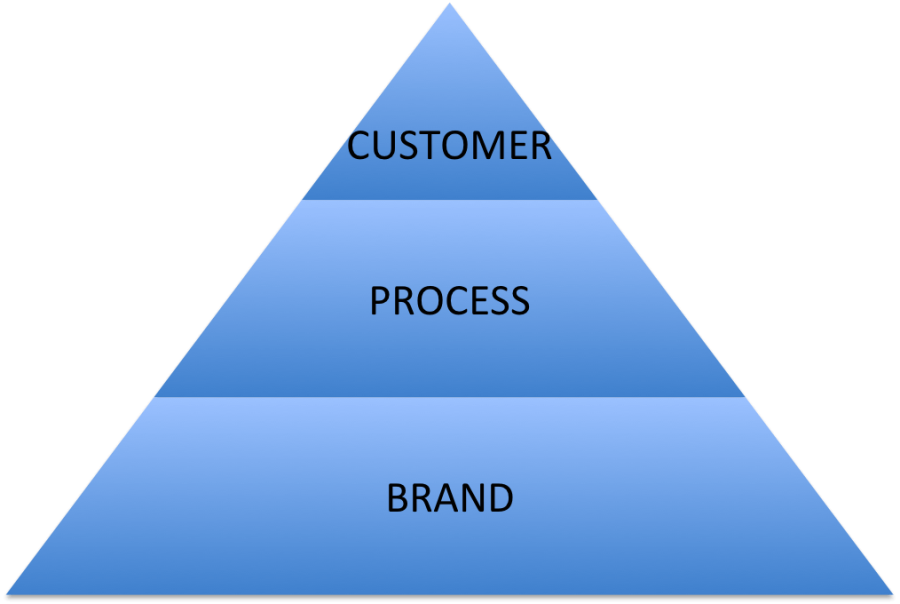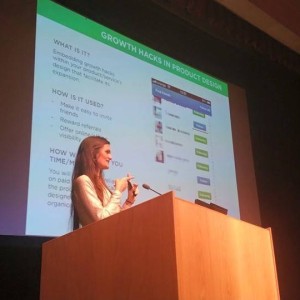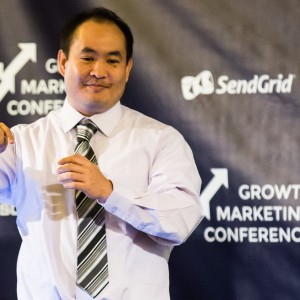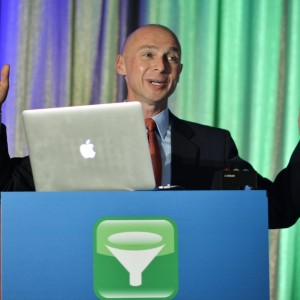Over the last 7 years, I’ve worked with hundreds of marketers, startup founders, growth and sales hackers, and corporate digital executives.
And from big conferences and hands-on workshops, to webinars and intimate cocktail mixers, I’ve noticed they’re all starting to talk about the same thing – growth marketing.
Which is why this year, I promised myself something. I made a resolution. I reached out to all the industry movers and shakers I could and asked for their growth marketing secrets – the tactics that just worked.
Because whether you’re a startup building a foundation to attract (more) funding, or an enterprise creating a platform for innovation, you really need to learn how to grow. From Silicon Valley dorms to New York City boardrooms, digital marketing teams are becoming growth marketing teams.
And it’s no surprise.
Growth marketing isn’t just a start-up thing. Growth marketing is a marketing thing.
And like with most business sea changes, you’re either onboard or you’re overboard. It’s just a matter of time.
That said, even though we’re still in the (relatively) early stages of the growth marketing revolution, we can still make sense of it.
First, sales is key to growth. Marketing, like any part of a business, shouldn’t operate independently. If you don’t link your marketing and sales teams, you won’t make as much progress – or as quickly – as you could. Sales, data analysis, and tech tools will be essential to your growth plan.
Second, most of the information out there on growth marketing is surprisingly easy to organize. The top strategies, tactics, and tips fit nicely into 3 categories: brand, process, and customer.
And today, I’m going to talk about those categories and the growth marketing secrets in them.
Let’s get started.
I. Brand
Whether it’s your personal brand, your company’s reputation, or your product’s image, it all starts with how people see you – including whether or not they can trust you.
In simple terms, many startups concentrate too much on creating an excellent product and not enough on developing a strong brand. They might have the top product available – they could even create a completely new product category – but they won’t profit if they can’t get customers to spend their money.
Unsurprisingly, many of the growth marketing lessons I learned revolved around branding. Some of the best ones are:
#1 Brand is Product
“Branding is something that starts when your first product launches. Your brand and product don’t compete. Your brand is your product.”
- Laura Busche, Brand Content Strategist, Autodesk
#2 Protect Your Brand’s Reputation
“You can have the best campaign idea, fabulous content, and great timing, but it won’t matter if you’re not protecting your clients’ data. It’s 2016. It’s time to take cyber security seriously and realize that data breaches negatively impact your brand’s reputation; they are the opposite of “growth.” Secure passwords and two factor authentication are no longer enough; you need a brand reputation management tool or service.”
- Natascha Thomson, CEO, MarketingXLerator
#3 Amplify Your Brand Awareness with Social Advertising
“Are you systematically tracking all the good things people say about you and your brand? You can amplify those words to your target audiences on Facebook, Google, and other networks for only a dollar a day. Nothing has more credibility than what others say about you. So shift your content marketing towards generating rave reviews instead of creating “advertising” content. Let your community of fans and customers do the work for you.”
- Dennis Yu, CTO, Blitz Metrics
#4 The Foundation for Growth is Excellence
“Quality service, quality product, and fair prices. That combination will always attract people. But more than that, it will inspire them to pass your name along to their friends, too. On Facebook, in person – everywhere. People love to tell their friends about great deals from quality businesses. And in today’s world of instant reviews and “search-about-you-first” consumer behavior, it’s critical that your entire footprint says quality. No one marketing tactic will build your business. no one product will solve your revenue issues. In the long run – and business is always a long game – quality wins.”
- Duane Forrester VP, Organic Search Operations, Bruce Clay, Inc.
#5 Build Relationships that Build Your Business
“Identify an area where developing new skills will make a significant impact on your business. Then identify a small group of accomplished people with these skills and build relationships with them. For instance, I finally became a book author and now believe I need to master promotional strategies to get it sold and read, so I’m working on connecting with non-fiction authors and book marketers who know the turf. When they’re carefully chosen and cultivated, new relationships are rewarding beyond measure.”
- Barry Feldman, Feldman Creative
#6 Invest in Your Social Capital, Not Your Social Media
“We often misinterpret the true value of social media. It is not about “likes,” comments, or money. It is all about relationships and people. It is not about business-to-consumer; it is not about business-to-business. It is people-to-people and how you make them feel.“
- Brian Solis, Principal Analyst, Altimeter Group
#7 Promote Others
“Promoting others is one of the fastest paths for growth for a startup. By promoting others, you’re giving them a reason to promote you – making the growth rate exponential. One way is to show how others have used your product to their benefit, which teaches people how to use your product and markets it at the same time.”
- Shira Abel, CEO, Hunter & Bard
#8 Find Your Story
“Find your story. Studies show that 63% of people remember stories and only 5% of people remember facts. When you want to educate or inspire your customer, give them a story – a pointed story that evokes an emotion (joy, fear, inspiration, etc.) that supports your call to action.”
- Olivia June, Co-Founder, VINA
#9 Leverage Your Passions
“You cannot avoid the social interaction of networking – especially in the Bay Area. Whether it’s going out to dinner with friends, running into an old acquaintance from college, seeing a co-worker outside of the office, or being introduced to a new connection, this city is an open arena for social networking, which makes it great. My advice is to not only attend networking events, but find some fun, exciting and interesting things to do – join clubs, groups, teams, or whatever it may be – and get involved with others who share similar interests. In essence, leverage your passions. In doing so, you directly leverage your networking.”
- Braydan Young, Account Executive, Gild
#10 Don’t Sell to Reporters; Share Relevant Information Instead
“Good PR isn’t about selling a reporter to write about you. It’s about relationships and being a part of the conversation. Load all the keywords about your industry and company into Google Alerts, then respond directly to the reporters when it’s relevant to them. Share your knowledge with them – when the time is right.”
- Julia Wells, Founder and Managing Director, CoveredCo
#11 Get Featured Everywhere You Can
“You’re an expert on your product, so tell everyone about it. Ask to be featured in publications and at conferences. You’ll be surprised at how many people say yes. The key is to get in front of as many interested eyes as possible, and optimize the buyer funnel to a conversion. Special attention should be paid to audience, non scalable activities and big picture analysis.”
- Clayton Wood, Founder & CEO, Identity Labs
#12 Leverage the Passion of Existing Users
“The source of organic growth is always the passion of existing users. Passion can be measured – it may be they actively promote you, it may mean they act as a case study, it may mean they get a tattoo of your logo on their arm. If you can rapidly learn which metrics tell you why your customers become passionate about you, you’ll have a great shot at rapid growth.”
- Jeremiah Gardner, Author of The Lean Brand, Principal, Moves The Needle
II. Process
Even a strong brand – along with a great product – isn’t enough. We’ve seen more than a few big brands and promising startups vanish because they couldn’t scale, manage their growth, or innovate when the time came.
And as most growth veterans would tell you – tactics and strategies are great, but they don’t lead to sustainable growth alone. They provide quick bursts of traffic – that’s what they’re for.
What you want is retention. Retention is king. And that’s why you should focus on building sustainable processes to attract, convert, and retain customers.
Some ideas for doing that are:
#13 Market to Influencers
“Group your potential customers around the problem you’re solving and determine the depth of problem. Next, figure out who influences the members of that group – within the problem’s context – and where they “hang out” together. Whether you’re doing customer development or trying to scale, leverage the relevant influencers and focus your marketing on where they are.”
- Brant Cooper, NYT Bestselling Author, Keynote Speaker; Founder, Moves the Needle
#14 Think Global, Act Local
“When you consider opening your service or product to international markets, think locally. Marketing is different from one culture to another. Google is far from being the top search engine in Russia, and Facebook isn’t even available in China. Your search, social, and content marketing strategies need to be unique for every new market you enter. Thinking locally is the first step to becoming a global brand.”
- Anji Ismail, CEO & Co-Founder, DOZ.com
#15 Measure Engagement and Influence
“When you go after bigger accounts, you can’t measure your marketing’s impact with just leads and opportunities. The larger the deal, the less you should think about measuring “marketing sourced pipeline” and the more you need to look at metrics like account engagement, revenue influence, and improved sales effectiveness.”
- Jon Miller, CEO and Co-Founder, Engagio
#16 Try. Fail. Learn.
“Don’t be afraid to fail. The only true failure for a lean startup is not trying new things. Nobody gets it right the first time – even if they say they did. Try. Fail. Learn. Repeat. But do it fast! That’s the lean approach.”
- Martyn Crew, Founder and CEO, Bootstrap Marketing
#17 Don’t Write Big Sales Playbooks.
“You absolutely need aggressive sales development – do multiple touches by email and phone for both inbound and outbound leads. But don’t write up big sales playbooks, because no one reads them. Sales development solutions are affordable for small teams and you’ll get more touches per representative (and thus more conversions) per week with them. And best of all, you won’t waste your time writing something nobody will read!”
- Nilay Patel, Co-Founder & CEO, Selligy
#18 Focus On How We Sell
“In this time of abundant, immediately available information, about every product and technology imaginable, how we sell is much more important than what we sell. The days of salesperson as purveyor of production information, features, and benefits is long gone.”
- Frank Slovenec, Partner, Jack B. Keenan
#19 Embrace Social Selling
“Use social networks like LinkedIn and Twitter to find and be found. The modern buyer is digitally driven, socially connected, mobile, and empowered. Social media is an additional channel for building relationships that drive revenue. Furthermore, you can use social media to shine the spotlight on your best salespeople – your customer advocates. Your employees need to look as good online as they do offline, so have them optimize their social profiles to attract customers. If you suck offline; you’ll suck more online. #Don’tSuck.”
- Jill Rowley, Keynote Speaker, Social Selling Evangelist, Startup Advisor, Investor
#20 Drill Smarter
“Selling a startup’s product is like prospecting for oil. And it is tempting, when you see oil seep into the first well you dig, to just keep drilling. But that’s dangerous. To scale, you need to tap a gusher. That first taste of oil – like a great customer call, for example – can keep you from moving on to where you should really be drilling.”
- Ryan Nichols, CEO, Tylr Mobile (ex-Appirio)
#21 Create Your Moment of Truth and Make It Count
“Create a reason for why a customer just has to hear you out, something so compelling, that stokes their curiosity so much, they can’t help themselves but meet with you. Then you have a single moment of truth to convince your prospective buyer you can really improve the way they do something. The key to this moment of truth is to have a well-honed and repeatable way of showcasing the value of your product or solution – including product demos, ROI stories, passionate quotes, and statistics. The more you deliver this personalized story consistently, the better you will get at it – and the more business you will close. Focus on making these moments of truth count.”
- Jim Benton, Co-Founder & Chief Business Officer, ClearSlide, Inc.
#22 Find Compatible Sales Talent
“Engineers do a great job of creating startups with strong initial traction. But too often they don’t understand that a “one-sized-fits-all” approach to sales just doesn’t work. They make the mistake of hiring “seasoned and experienced sales veterans” from traditional and established tech companies, which is usually too much too soon and results in bad outcomes and lost time. Founders should consult with sales veterans that understand the startup landscape and can recommend near, middle, and long-term sales plans and strategies for a fixed fee or company stock tied to specific deliverables and milestones. Just because a sales strategy worked at Oracle or Salesforce doesn’t mean it will work at your startup.”
- Dwight Foster, Vice President of Channel Sales and Business Development, Insightly
#23 Go Niche
“Startups need to master niche media. There are thousands of journalists and bloggers covering every aspect of technology, but only a handful matter to your audience and to your business. Use hashtags on social media to identify the keywords your audience users to share their hopes and frustrations. Then look for publications and journalists who use these industry-specific words in their stories. These are the niche media outlets you have to target, because they’re the ones your customers and prospects go to for relevant, actionable information.”
- Chikodi Chima, Growth Expert and Founder, Moonshot
#24 Align Your Paid Search and Social Advertising Campaigns
“Organize your strategy into 4 components to help analyze and optimize everything. Paid search and social media advertising can be extremely competitive. And don’t forget to monitor competitive keywords, ads, and landing pages.”
- Jamie Smith, CEO, Strategy Analyzer | VP of Growth, iSpionage
#25 Develop a Video Marketing Strategy
“Leverage video marketing to promote your startup company or product. YouTube is the second most popular search engine in the world and videos can even rank on Google’s first page. If you’re not sure what to make your video about, try a video business card, client testimonial, or “how-to” instructions on the best uses of your product or service. Then promote your video on all of your social media accounts – from Facebook to Instagram – to share your video with the word.”
- James Hickey, President, JMH Marketing Group
#26 Focus and Clarity
“When thinking about business opportunities, cultivate an objective, impartial mindset that takes everything – from business factors to personal ones – into consideration. We’ll call this mindset “clarity.” From there, you can figure out what the right opportunity for you is and push toward it, adjusting and optimizing as necessary to realize it. We’ll call that push “focus.” First clarity, then focus. Because without clarity, you’ll likely to go a long way in the wrong direction.”
- Aaron Kahlow, Founder and CEO, Mindful Living Institute
#27 Sales is the Art of the Next Steps
“The best way to keep your sales moving forward is to always have a clear action for your prospect to take next. When there’s no clear next step, the sale stalls or falls apart. But when they know exactly what to do next, you’ll get to a decision quickly and count the win or move on to find the next opportunity.”
- Liston Witherill, Chief Builder, Good Funnel
#28 Growth is All About Retention and Engagement
“Growth is meaningless without retention and engagement. If you don’t nail the reason why users would continue to use your product habitually, your product is just another leaky bucket.”
- Nir Eyal, author of “Hooked: How to Build Habit-Forming Products”
#29 Before Growth Focus on Fundamentals
“Like conversion rate optimization before it, growth hacking case studies can sometimes blind practitioners to the fundamentals of growth by focusing too much attention on tricks and shortcuts. Airbnb’s famous Craigslist hack would never have worked if Airbnb was not fundamentally a novel service that offered a real advantage over traditional lodging. Undifferentiated Product + Growth Hack = slow growth. Innovative Product + Growth Hack = viral growth. Don’t skip step one.”
- Forrest Dombrow, President, Solve Sales
#30 Leverage Other People’s Newsletters
“Every industry has a few luminaries and many more popular bloggers and other influencers, all of whom have regular newsletters that reach many thousands of readers. Leveraging their newsletter’s reach gets the word out about your product to a very engaged audience. Offering an something special for the newsletter is incentive to both the sender and reader and can drive some serious growth.”
- Dean Levitt, Chief Of Culture, Mad Mimi, LLC
#31 Apply Keyword Research Fundamentals
“Apply keyword research fundamentals (SEO and paid search) to your content marketing calendar, but don’t forget to consider your sitemap, hierarchy, and navigation elements (what your site looks like), and make sure you have the right words represented on your pages where people are likely to click, with a mix of high volume + high affinity to your qualified audience.”
- Chris Boggs, Founder, Web Traffic Advisors
#32 Keep Track of Your “First Major Win-State”
“In designing your campaigns, you must keep track of your “First Major Win-State” – the first point where users say, “This is awesome!” Once you identify that point, count how many minutes it takes for a user to reach it, because every second before that is a drop-out. And don’t forget to ask your users to tell their friends about you and rate their experience – right after your “First Major Win-State” victory.”
- Yu-Kai Chou, Pioneer and International Keynote Speaker on Gamification
#33 Grow the Right Audience
“Growth is about more than just acquiring users. It’s about acquiring the right users – the ones who will engage and convert and generate revenue for years to come. If you want to find more of the right kind of users, try talking to your best customers right now. Ask them where they heard about your product, what they expected from it when they started, and what they’re getting out of it. Then use that information to find better channels and the right messaging to attract more people like them.”
- Laura Klein, Principal, Users Know & Author of UX for Lean Startups
#34 Act on Your Analytics
“In the pursuit of growth, one of the most important analytical capabilities you must have in your startup is the power to segment users by the actions they have or have not performed in the product. The ability to act on user behavior data can have an absolutely transformational impact on your growth trajectory.”
- Jack Mardack, Head of Growth, Chartcube
III. Customer
And finally, we come to the customer. The person you’re selling to. The one who’s going to use your product – and love it or hate it. The one who ultimately determines whether your business makes it or doesn’t.
It’s not hard to see that we should take the customer into consideration. But sometimes we could use a little help on how to get it right.
Here are a few tips:
#35 Focus on Solving Your Customer’s Problems
“Stop thinking about your business. The absolute focus must be on problems that your potential already customers have, and how you might help them solve them. The are not looking for your features or “solution” – they are trying to avoid or minimize a specific pain.”
- Tim Ash, CEO, SiteTuners, bestselling author of “Landing Page Optimization, Chair of Conversion Conference”
#36 Know Your Customer – Intimately
“Before you think about funnel optimization, A/B testing or distribution, take the time to know your customer – intimately. Find them, talk to them, be where they are. By truly understanding their feelings, behaviors and attitudes, you can build better products and tell a story that will resonate with them.”
- Hana Abaza, VP Marketing, Uberflip
#37 Find Early Adopters and Turn Them Into Brand Evangelists
“When building out your initial user base, find people who are interested in your product or service and connect with them. How do you do that? Find people who commented on related articles, tweeted or retweeted about the topic, shared a post on Facebook or Instagram, etc. Then follow up with them on their platform of choice and engage them. These people have demonstrated interest in your product/service and can become your first adopters, evangelists, or VIPs (if they are press or influencers).”
- Adelyn Zhou, Founder and CEO, Alight Labs
#38 Become a Tribe Leader
“Turning your audience, or email list, into a tribe – a community united around a central topic – will build your brand better than any marketing strategy you could set forth. Let people join together to talk about a problem or solution, and you will learn their biggest challenges, their objections, how they speak about the solution, and, most importantly, how to better serve them. ROI, NPS, referral rates, LTV will all go up, while CAC drops. There’s nothing more powerful to your business than leading your community.”
- Derric Haynie, CEO, SplashOPM
#39 Know Your Buyer
“The company that understands their buyers best will earn their business and their loyalty. Growing your business in 2016 isn’t about being the loudest brand on every channel possible, but about using sales and marketing to demonstrate that you know your buyer better than the competition (and that you’ve got the product and experience to match).”
- Katie Martell, Co-Founder and CMO, Cintell
#40 Ask Your Users How They Learned About You
“At Bunny Inc., we directly ask every user how they learned about us and we leave the answer field open-ended (no bullet points). This helps us discover new channels for customer acquisition and to understand which acquisition channels are performing the best.”
- Jun Loayza, Chief Growth Officer, Bunny Inc.
#41 Viral Growth
“When thinking of viral growth, don’t fall for the trap of thinking that this simply means getting lots of shares on social media. This is simply one of 12 types of viral marketing that you can build deep into the bones of your product to help recruit your loyal users to recruit even more loyal users for you. Things like making your product embeddable, inviting friends or colleagues to collaborate on a project using your product, or anything else that adds value to the user for inviting others can skyrocket your growth.“
- Travis Steffen, Head of Growth, AutoLotto, Inc
#42 Lower Friction to Increase Growth
“It doesn’t matter how much money you spend on marketing; the secret weapon people don’t think about is how long it takes to sign up for a service. The less take it takes, the higher the growth.”
- Michelle Zatlyn, Co-Founder and CEO, Cloudflare
#43 Address Users’ Objections
“Ask users who say they would not buy your product what their objections are during moderated user testing. Dispel, or at least address, those objections explicitly in your home page or landing page copy. Watch conversions increase dramatically.”
- George Revutsky, Founder, ROIworks Digital / Chief Merketing Officer, Soothe
#44 Learn What Your Customers Love and Hate
“Building a demand for your product can take time. To speed this up, start right now to build thought leadership content (blog posts, white papers, etc.) and network with experts in your industry to learn what customers love and hate in your business niche. Most importantly, make sure everyone knows who you are.”
- Michelle Regner, CEO and Co-Founder, Near-Me.com
#45 Keep it Simple
“At the core, marketing is not that complicated. We are the bridge between the audience and the brand. What makes it complicated is that we get in our own way and we want to talk about ourselves. Marketing gets really simple when you understand what you can bring that your audience really wants. If you live through that lens, 50% of your problems go away right then and there.”
- Todd Wilms, VP Corporate Marketing, VERISIGN
#46 Build Organic Growth First
“There will always be dozens of email marketing and other software vendors trying to get your business as you grow. Before you go and burn $12k or $24k signing up for a 1-year contract with them, be sure that you know how to grow your SaaS company by 5-7% week-over-week organically. Until you reach that point, it could be detrimental to your company to spend this budget..”
- Adam Metz, VP, TerrAvion
#47 Measure the Product Fit First, Then Focus on Growth
“Ask your users a question: “How would you feel, if you could no longer use product or service?” If you get to 40% percent of “very disappointed” responses, you have a marketable product. After this is done, you have to understand why it is a must-have product for your customers to be able to create a machine to deliver that value”
- Sean Ellis, Founder and CEO, GrowthHackers.com / Product and Growth Advisor, KISSmetrics
#48 Growth Is All About Word of Mouth
“At the end of the day, growth is all about word of mouth. People tell their friends about your product after they have a great experience using it. Before you invest in testing your viral funnels, digging into your SEO strategy and spending precious dollars on marketing campaigns, make sure that you have a product that delights your user.”
- Zack Onisko, VP, Hired, Inc.
IV. Wrapping Up
Though all these strategies and tactics will do great things for your growth – and don’t forget who told you about them! – it won’t be enough. Nothing will, sadly.
Unless you want your company to reach a certain point and then stop. Just stand still. Stagnate. Lose out to a hungry young competitor.
No, you have to keep growing. Keep moving. Growth marketing – like regular marketing, or sales, or accounting – is never really over. It’s a way of life.
But then again, that’s a good thing. It gives you something to keep working on. It gives you a job, too. One that can’t be automated.
However, it does require you to stay current on what’s happening in the industry, because growth hacks that work now may not work tomorrow, and new opportunities pop up all the time.
Be sure to follow marketing blogs, attend conferences, and catch cocktail mixers and webinars when you can. In fact, there’s a Get Traction: The Virtual Growth Event coming up soon you might like to look into.
But whatever you do, whatever resources you use, you have to keep learning. And don’t worry – you won’t be alone. I’ll be there right with you.
And all your competitors will be too.









